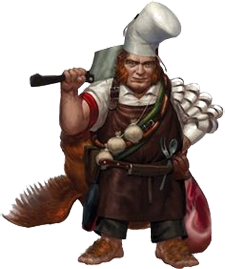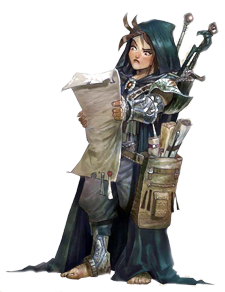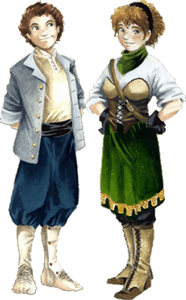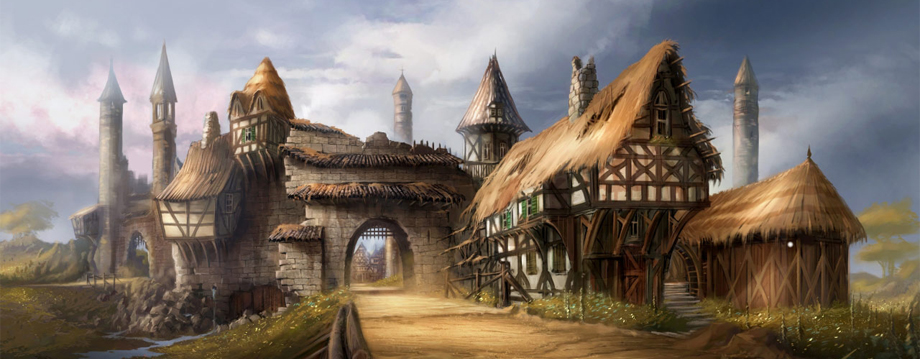Most outsiders believe that halflings lead a happy-go-lucky life, free from cares and responsibilities. As is often the case, however, the truth is quite different. Though having minimal possessions does avoid many of the problems faced by more settled folk, halflings must endure cold, rainy nights, hunger when food is scarce, attack by monsters in the wilderness, wagons stuck in the mud, rocky trails, and a general lack of privacy. The fact that they can face such difficulties and still wear the carefree smiles that most people associate with them is a tribute to the halfling spirit.
Halfling culture is not as old or as developed as that of the elves, but its diversity provides a richness of its own. Like a quilt sewn by many hands, halfling culture is a patchwork of different styles, arts, and attitudes. Though most halflings espouse the same general principles, each caravan (or sailing ship, for seafaring halflings) forms a subculture of its own, with particular customs, rules of behavior, rituals, and even speech patterns. Halflings recognize this diversity and are always eager to learn the customs of others of their kind. The constant turnover among the people in a given caravan ensures that each subculture continues to grow and evolve.
Most halflings adopt noncombat professions such as blacksmith, animal herder, or some other function within the caravan. A high percentage leave the caravan at some point to take up adventuring. The halfling’s need to see what’s around the next bend or behind the next door is never served as well as in an adventuring career.
Arts and Crafts
Like humans and dwarves, halflings usually specialize in crafts and professions, with each person occupying a necessary niche in the community and providing a particular service throughout his life. Each caravan has a blacksmith, a wheelwright, a wagon builder, a butcher, various cooks, hunters, animal trainers, spinners, weavers, priests, tinkers, jewelers, and general laborers. Nearly all halfling NPCs in a caravan specialize in one primary skill and take one or two ranks in several others that they have developed in case someone needs to fill in for another member of the caravan who has become ill or disabled. Such secondary skills also stand halflings in good stead when they camp near other humanoid communities and hire themselves out.
 Crafts are the primary outlet for a halfling’s creative side. Halflings create very little art for its own sake; there is usually little money in such endeavors. Why spend weeks making a lovely painting or statue that will have to be carried around for months and months, taking up valuable space in someone’s wagon? Better to carve and paint children’s toys and sell them at the next stop. Halflings do, however, enjoy embellishing the items they use in daily life. Some paint designs of remark-able beauty on the sides of their wagons; others make jewelry or embroider clothing for their own use. Such use of one’s creative abilities is beneficial to both the individual and the community. Brightly colored wagons can draw attention from other humanoids, attracting them to the camp, so the halflings can easily transact business with them. Likewise, striking clothing and jewelry sometimes speaks more of prosperity than of a vagabond lifestyle, which tends to put more stable businesspeople at ease.
Crafts are the primary outlet for a halfling’s creative side. Halflings create very little art for its own sake; there is usually little money in such endeavors. Why spend weeks making a lovely painting or statue that will have to be carried around for months and months, taking up valuable space in someone’s wagon? Better to carve and paint children’s toys and sell them at the next stop. Halflings do, however, enjoy embellishing the items they use in daily life. Some paint designs of remark-able beauty on the sides of their wagons; others make jewelry or embroider clothing for their own use. Such use of one’s creative abilities is beneficial to both the individual and the community. Brightly colored wagons can draw attention from other humanoids, attracting them to the camp, so the halflings can easily transact business with them. Likewise, striking clothing and jewelry sometimes speaks more of prosperity than of a vagabond lifestyle, which tends to put more stable businesspeople at ease.
Textiles, fashion design, metalwork, jewelry making, weaponsmithing, armor-smithing, woodworking, pottery, and other such endeavors are all considered viable expressions of one’s artistic self, and even painting has its place when used for the embellishment of otherwise utilitarian objects or for profit. Skill at architecture is nearly unknown among halflings, because so few of them build permanent structures.
 Music is an art form that every halfling can appreciate. It not only helps to bring in coin but also lifts the spirits after a long, hard day of travel. It provides the framework for dancing, an indulgence of which halflings are particularly fond. Only when the need for silence is great does a halfling go without his music. Someone in the camp is almost always playing a tune, and while the caravan is on the road, singing, whistling, and humming make the trip more pleasant. Favored instruments among halflings include lutes, lyres, horns, and small drums, as well as more exotic string and percussion instruments acquired at some point in their travels. Their best-known compositions are merry tunes that draw listeners into dancing. Among their own people, however, songs of the open road and laments for the departed that can draw a tear from even the most stoic eye are equally prized.
Music is an art form that every halfling can appreciate. It not only helps to bring in coin but also lifts the spirits after a long, hard day of travel. It provides the framework for dancing, an indulgence of which halflings are particularly fond. Only when the need for silence is great does a halfling go without his music. Someone in the camp is almost always playing a tune, and while the caravan is on the road, singing, whistling, and humming make the trip more pleasant. Favored instruments among halflings include lutes, lyres, horns, and small drums, as well as more exotic string and percussion instruments acquired at some point in their travels. Their best-known compositions are merry tunes that draw listeners into dancing. Among their own people, however, songs of the open road and laments for the departed that can draw a tear from even the most stoic eye are equally prized.
Though most halflings have a talent for acting, they produce very few plays because such forms of entertainment tend to consume resources while doing little to mend wagons, accrue wealth, or cook dinner. Impromptu skits, however, are quite popular within certain caravans, and less than flattering representations of other races often add to the frivolity.
Among the most important arts in a halfling community is storytelling. Halflings write down practical information, such as supply lists and transaction records, but they rarely take the time to record legends or gossip. The oral tradition is stronger in the halfling race than almost any other, and almost every halfling is an accomplished storyteller. Telling tales around the campfire has been a tradition among travel-ing halflings for as long as anyone can remember, and the frequent turnover in caravan personnel ensures that there are always new tales to hear. Though in many cases the tales amount to little more than gossip, word of important events spreads quickly through the halfling race from caravan to caravan. Halflings have a deep respect for the oral tradition and thus attach an absolute minimum of embellishment to the original tales. Thus, a tale spread from one end of a continent to the other will be substantially the same as when it was first told.
Several times each year, a number of caravans gather in a prearranged location for a storytelling fair. They hold contests for the best tales and the best renderings, and they present cash prizes as well as accolades to the winners. These week-long events also feature craft booths, trained animal acts, feasting, and other forms of entertainment. Outsiders are welcome, but few ever attend, put off by the prospect of so many thieves and con artists gathered in one place.
Technology and Magic
Most halflings believe that magic is great for driving off orcs, entertaining outsiders, and dealing with the occasional emergency. In the long run, though, technology is often more practical and more reproducible. After all, just about everyone who makes a wagon wheel goes about it the same way, and if you studied a wagon wheel long enough, you could probably get a good idea of how to make one. In contrast, two spellcasters may cast the same spell in entirely different ways, and no one—not even experienced wizards—can figure out how to reproduce a spell just by seeing its effect.
 The study of magic is a niche activity in halfling communities. Everyone appreciates having a few wizards, sorcerers, and clerics around for emergencies, but their usefulness is limited in daily life. Magic items, however, are another matter entirely. With only minimal instruction, anyone can use many items of power; those that are not needed can be sold for good prices. Thus, spellcasters who travel with halfling caravans often find themselves pressured to either create magic items or find something productive to do with their time. Most halflings who pursue such classes also have other professions that are more useful to the community on a day-to-day basis.
The study of magic is a niche activity in halfling communities. Everyone appreciates having a few wizards, sorcerers, and clerics around for emergencies, but their usefulness is limited in daily life. Magic items, however, are another matter entirely. With only minimal instruction, anyone can use many items of power; those that are not needed can be sold for good prices. Thus, spellcasters who travel with halfling caravans often find themselves pressured to either create magic items or find something productive to do with their time. Most halflings who pursue such classes also have other professions that are more useful to the community on a day-to-day basis.
Halfling spellcasters rarely do research, and they display a preference for magic of the illusion, transmutation, and conjuration schools. Abjurers and diviners are also relatively common, while necromancers are practically unknown. Arcane spellcasters usually travel with their clans, but each usually has a wagon of his own; most halflings find it prudent to give wizards and sorcerers a wide berth in case of accidents.
Halfling technology focuses primarily on practical items and transportation. Small, portable items are favored so that they can easily be carried in wagons or on one’s person. Any item that makes daily life easier or can get a caravan out of trouble is of great interest to a halfling band. Heavy, bulky items and equipment are of little interest to halflings unless they can see a way to sell such items at a handsome profit.
The legend that claims halflings invented horseshoes is probably false; halflings use goats more often than horses. Still, that bit of lore does speak to the depth of the halflings’ passion for transportation-related equipment. Goat carts, ox carts, mine cars, boats, gliders, and all other kinds of conveyances are fascinating to halflings, and they have improved on most of the traditional designs. Animal breeding and training is also an essential part of halfling technology because animals power many of the halflings’ conveyances and provide food for the caravan. Halflings have developed breeding to a science and can reliably produce animals with more meat, greater speed, or more endurance than those raised by most other races.
Upgrades in transportation, food preservation, medicines and tonics, and other technology of interest are quickly passed from one caravan to another—and to human, dwarf, gnome, and elf communities as well. Even technology that did not originate among the halflings spreads quickly once they get hold of it.
Love
Love is a vital part of life, and halflings enjoy it to the fullest. They are devoted to their families; the affection between children and parents, siblings, spouses, and extended family members such as grandparents and cousins is deep and unyielding. So great is the halfling devotion to family that two halflings who meet for the first time are likely to spend hours comparing genealogies to figure out how they might
be related. Should a familial relationship be discovered, no matter how remote, the two treat one another like long-lost siblings—at least until one does something perfidious enough to sour the relationship.
Halflings are as eager to experience romantic love as any other humanoids. To them, romance is just another great adventure that may bring weal or woe. Infatuation is common among halflings, and since offspring frequently result from such liaisons, lovers typically formalize their relationships as soon as possible. Romantic relationships between members of the same caravan or clan are discouraged but not strictly forbidden.
 Two levels of marriage exist within halfling society. Handfasting is one method of formalizing a relationship within a halfling community. Only the two lovers and three witnesses of their choice need be present to complete this ritual. The lovers’ hands are usually bound together with leather thongs; these are removed, knotted together, and presented to the couple at the end of the ceremony. The lovers speak their own vows, which usually consist of a promise to look out for one another’s welfare and remain faithful for as long as love lasts. Handfasted couples are entitled to their own wagons. If neither party already owns a wagon, one is built by the community at the earliest opportunity and presented to the couple as a gift. Until then, such a couple usually lives in the wagon of one or the other’s parents. Handfasted couples are expected to live and work together as long as they feel affection for one another. Some handfastings last for decades, and a few last for life. Often, though, because halflings are intensely curious creatures, one partner becomes interested in someone else, or perhaps one wishes to leave for an extended period to go adventuring or join another caravan; and sometimes arguments simply poison the couple’s love. In such cases, couples can end their handfasting with a brief ceremony in which the knotted cords they received earlier are untied before three witnesses and presented to the now-separate individuals. Children of such a couple live with whichever parent wants them. If both do, a child can choose if he or she is old enough to speak; younger offspring remain with their mother unless she refuses them. The second level of formalization is true marriage. Marriages are much rarer than handfastings and cannot occur between members of the same clan. Most marriages occur much later in life than handfastings, after the lovers have had a chance to live together as a handfasted couple and become certain of their love. Some couples never take this step at all, content to remain handfasted for their entire lives. A marriage is conducted by a cleric and sparks a week of celebration in the entire community. Most married couples already have wagons, but those who do not receive them from the community, just as handfasted couples do. A newly married couple is showered with gifts, and both husband and wife are instantly accorded the position of elders within the community.
Two levels of marriage exist within halfling society. Handfasting is one method of formalizing a relationship within a halfling community. Only the two lovers and three witnesses of their choice need be present to complete this ritual. The lovers’ hands are usually bound together with leather thongs; these are removed, knotted together, and presented to the couple at the end of the ceremony. The lovers speak their own vows, which usually consist of a promise to look out for one another’s welfare and remain faithful for as long as love lasts. Handfasted couples are entitled to their own wagons. If neither party already owns a wagon, one is built by the community at the earliest opportunity and presented to the couple as a gift. Until then, such a couple usually lives in the wagon of one or the other’s parents. Handfasted couples are expected to live and work together as long as they feel affection for one another. Some handfastings last for decades, and a few last for life. Often, though, because halflings are intensely curious creatures, one partner becomes interested in someone else, or perhaps one wishes to leave for an extended period to go adventuring or join another caravan; and sometimes arguments simply poison the couple’s love. In such cases, couples can end their handfasting with a brief ceremony in which the knotted cords they received earlier are untied before three witnesses and presented to the now-separate individuals. Children of such a couple live with whichever parent wants them. If both do, a child can choose if he or she is old enough to speak; younger offspring remain with their mother unless she refuses them. The second level of formalization is true marriage. Marriages are much rarer than handfastings and cannot occur between members of the same clan. Most marriages occur much later in life than handfastings, after the lovers have had a chance to live together as a handfasted couple and become certain of their love. Some couples never take this step at all, content to remain handfasted for their entire lives. A marriage is conducted by a cleric and sparks a week of celebration in the entire community. Most married couples already have wagons, but those who do not receive them from the community, just as handfasted couples do. A newly married couple is showered with gifts, and both husband and wife are instantly accorded the position of elders within the community.
The primary difference between a wedding and a handfasting is that a wedding is for life. The halflings involved may not dissolve the union, and any attempts to separate or stray result in the expulsion of the guilty party or parties from the community. Thus, marriage occurs only between halflings who are quite certain of their ability to weather the storms of a relationship. Though true marriages occasionally go sour, the parties usually learn to resolve their differences and live together in (relative) harmony.
Reproduction
Halflings reach maturity at the age of 20, and both genders are capable of reproduction for approximately 40 years thereafter. The gestation period is seven months, a little shorter than that of a human. Female halflings rarely give up working, adventuring, or pursuing their usual activities while pregnant, at least until the last month or so. Halflings with infants or very young children often choose to halt their roaming for a few seasons, picking a good camp or a permanent halfling settlement (or even a human town) until the youngsters are a little older. Not all roaming halflings do this, though; some families never leave their caravans.
Halflings are adept at avoiding trouble, and halflings with small children especially so. Despite the perils of disease, weather, monsters, and orc raids, roughly eight in ten children reach maturity.
Halflings at War
Halflings rarely declare war on others—after all, winning might mean becoming tied down with property. In the same way, having no lands and few goods of their own means that halflings have little need to defend their belongings. No one starts a war just to take a few dozen wagons, though other races may fight long and bloody conflicts over pieces of land that are often quite small. Having little to lose and no interest in a permanent home frees a halfling to enjoy life in ways that other races can never appreciate.
Halflings are certainly not pacifists, however, and often find work as mercenaries in the wars of others. Their small size and aptitude for sneaking makes them excellent scouts, and their high Dexterity and racial bonus with thrown weapons makes them valuable in units employing ranged weapons. Though halflings have no fear of melee combat, they are prudent enough to avoid it when possible. Halfling infantry units are rare, though halfling cavalry can be surprisingly effective due to the halflings’ aptitude with animals and their penchant for doing the unexpected on the battlefield.
All halflings learn to use slings and javelins well before they reach maturity. Many also learn how to use short swords and throwing axes, as well as certain exotic halfling weapons such as skiprocks and war slings. A halfling’s first line of defense is usually a ranged weapon. Should an enemy get close enough for melee combat, the longsword or short sword is the most common choice.
Death
The much-vaunted halfling fearlessness extends even to death. Most halflings view death as simply the next great adventure. Though they do not court it, they take no pains to avoid risk, nor do they resort to necromancy or other magical means to stave off death. Halfling caravans hold funerals to mourn the loss of companions and also to celebrate their next great journey. Thus, a funeral usually has two parts: a grieving ceremony followed by a party. During the grieving portion of the funeral, the entire community gives vent to sorrow. The object of this portion of the ritual is to cleanse the souls of those left behind of their grief so that they can move on, both literally and figuratively. After all members of the caravan have cried as long as they need to, they sleep, then awaken and begin the celebration. Tables are set up with places for everyone, including an empty spot for the deceased. They roast meat, pile baked goods of all sorts on crude wooden tables, and tap barrels of wine and ale. Everyone eats, drinks, and dances. From time to time, someone stands up and tells a story (often humorous) involving the deceased, and tales of his life are woven into stories to add to the general tapestry of oral tradition that ties all halflings together. The storytelling and feasting last until everyone has fallen asleep, usually a full day and night.
After the party ends, the body of the deceased, if present, is brought to a funeral pyre built of branches and twigs and set alight. His ashes are then scattered to the four winds, so that he might continue his journey unfettered. The goods of the deceased are distributed to the remaining members of his family or, if no immediate family is present, to his clan.
If a funeral is held for a halfling who later turns up alive, he must take another name because his original identity has been laid to rest. Even if everyone knows who he is, he must begin again as a new member of the caravan and his clan.
